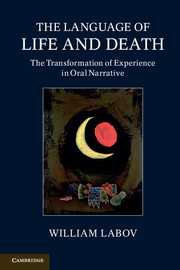Book contents
- Frontmatter
- Contents
- Preface
- Acknowledgments
- 1 Introduction to the language of life and death
- 2 Narrative analysis
- 3 The escalation of violence
- 4 Confrontations with death
- 5 Premonitions and communication with the dead
- 6 Margie Knott: “Her confrontation with the neighbors”
- 7 Gloria Stein: “They stoned the house”
- 8 Rose Norman: “The death of her younger sister”
- 9 Mary Costa: “The death of her youngest daughter”
- 10 Cache County
- 11 The vernacular origin of epic style
- 12 Historians' use of narrative
- 13 Thomas Babington Macaulay: “The death of Monmouth”
- 14 S. T. Bindoff: “The death of Elizabeth”
- 15 2 Samuel: “The death of Absalom”
- 16 The narrative view of death and life
- References
- Index
16 - The narrative view of death and life
Published online by Cambridge University Press: 05 June 2013
- Frontmatter
- Contents
- Preface
- Acknowledgments
- 1 Introduction to the language of life and death
- 2 Narrative analysis
- 3 The escalation of violence
- 4 Confrontations with death
- 5 Premonitions and communication with the dead
- 6 Margie Knott: “Her confrontation with the neighbors”
- 7 Gloria Stein: “They stoned the house”
- 8 Rose Norman: “The death of her younger sister”
- 9 Mary Costa: “The death of her youngest daughter”
- 10 Cache County
- 11 The vernacular origin of epic style
- 12 Historians' use of narrative
- 13 Thomas Babington Macaulay: “The death of Monmouth”
- 14 S. T. Bindoff: “The death of Elizabeth”
- 15 2 Samuel: “The death of Absalom”
- 16 The narrative view of death and life
- References
- Index
Summary
The central focus of this book is on the narrative techniques used to convey the life experience of one human being to another. The book is also centered about the termination of that life, and speakers' ways of dealing with the reality of death: when their own lives are in danger, when death suddenly overtakes someone close to them, when they are faced with the certainty of an oncoming death. The oral narratives presented here are not a random sample of those told in this domain. On the contrary, they are a selection of the most interesting and effective from thousands that have been elicited, recorded and transcribed in the course of fifty years of sociolinguistic research by me and my students. As such they are prototypical rather than typical. Although the research tradition they are drawn from is largely quantitative, this is not a study of variation in narrative structure, but a logical account of the generation of that structure.
The logic of narrative analysis
The following eight-point schema is proposed for the analysis of any given narrative or episode of a narrative. It draws upon the concepts developed in Chapter 2 and the results of applying these concepts in Chapters 4–15. It is to be understood here that “narrative” designates “oral narrative of personal experience” and that the extent to which the schema applies to other narratives will vary.
- Type
- Chapter
- Information
- The Language of Life and DeathThe Transformation of Experience in Oral Narrative, pp. 223 - 229Publisher: Cambridge University PressPrint publication year: 2013



